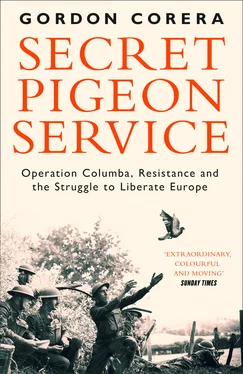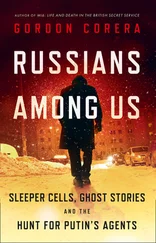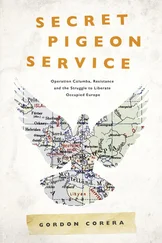In December 1914, he made his escape from the fort. The family story was that he hid under the hay in a wagon on the return journey of a farmer who had come to deliver food. The reality may have been somewhat more prosaic. German papers indicate that they had been unsure what to do with him, and because he had made himself useful as a cook he was allowed to travel to Stevoort in early December. It was from there that he may then have made his escape, perhaps indeed in a hay cart. Whatever the real story, he was out. He then went to the front lines, again as a stretcher-bearer. This was dangerous work, sometimes involving making one’s way right to the front to load up the battered and broken bodies of soldiers and then suddenly having to drop into the mud as German bullets whistled overhead.
He enjoyed a ten-day break in London – not knowing that a quarter of a century later the course of his life would be shaped by his attempts to reach out to that city once again. During that brief visit, there were visits to churches and museums, but Raskin had one problem. With his lively blue-grey eyes, rippled dark hair and infectious laugh, he was handsome, and he wondered how to explain to the local girls who seemed interested in him that he was actually a chaste priest.
When he returned to the front, Raskin’s peculiar skills opened the way for him to become something else – an artist-spy. Since his youth, he had been good with his hands as well as his head. He would repair clocks and generally tinker with things. He was particularly talented as an artist. So now, he began to go to the front line, initially of his own volition, to draw what he saw in front of him. The result were beautiful drawings of the trenches and German positions.
When his superiors in the Army saw the drawings, they immediately recognized their military value and they were passed up the chain of command to the highest levels. Raskin was dismissed as a stretcher-bearer and turned into an observateur – a kind of intelligence gatherer. He worked across the Belgian front, just north of Ypres where the British were fighting. It was a bleak, apocalyptic landscape. The Germans had initially advanced over the River Yser but the Belgians flooded the land to halt their advance. The Germans then partially retreated back over to one bank. The land in between was laid waste by a mix of water and war. Sometimes the two sides were close – at a place called the ‘trenches of the dead’ they were little more than twenty metres apart. But in other places, no man’s land was far wider and less clear-cut. Shredded trees stood amongst pools of muddy water with the remnants of farm life surrounding them. The Germans had established advanced observation points and positioned snipers in farmhouses across the desolate flooded plain.
Raskin would travel out at night. He would give a password to a sentry and then sleep for a while in a shell hole. At first light, as the birdsong began, he would begin to observe and sketch. Two men would accompany him and provide covering fire if needed. At night, when he had seen enough, he would return. Back in his bureau he would take the rough drawings he had made and turn them into something approaching art. There are beautiful pencil drawings and watercolours of the view from the Belgian side facing the Germans, with each German position carefully marked out. The largest, most dramatic panoramas he made are two feet long, works of art crafted from the art of warfare.
It could be dangerous. In mid-May 1916, he spent three days and nights without food or water trapped in an abandoned flour mill, full of rats, surrounded by Germans. Another time, a bullet shattered the lens of the periscope he was using.
Sometimes in the picture is what appears to be an abandoned building. Look closely and you can just see the eyes of a German soldier hiding in a gap ready to shoot. A caption notes that this was a permanent German observation point. There were also bird’s-eye views of the same front lines, again marked out in precise detail with map coordinates and distances. One map has arrows indicating not just the direction in which the Germans shot from each trench but how regularly they fired; for instance, whether they only fired in response to Belgian fire or just at night. At one farmhouse, it is noted that every time the Belgian artillery began firing, a German periscope popped up. At another point it is remarked that the Germans at night sent out patrols so close they would throw grenades into Belgian trenches.
Senior officers were impressed. One went so far as to put his signature on one of Raskin’s pictures, which led the priest to realize he needed to sign them himself to prevent others taking credit. In spare moments, the priest’s humanity shone through – he would make small pencil drawings of an exhausted fellow soldier having a cigarette or devouring a chunk of bread. And so, without knowing it, the first stage of his preparation for the English pigeon scheme was complete. Raskin had learnt the fine art of military intelligence – which information was of value, and how to present it.
When the war ended, Raskin became, as he had always intended, a missionary-priest. After celebrating his first mass, he boarded a white steamboat for the long journey to China. Pictures show the young man lounging on a bunk with fellow priests in second class and out on deck with a mixed group of priests and nuns, all smiling as they head out on their adventure. On the long voyage, Raskin would play the piano in the evening or draw pictures of fellow passengers. They made their way via Port Said and the Suez Canal, Singapore and Hong Kong before finally reaching China. A photograph shows Raskin in Shanghai, dressed in local clothes, learning how to write the local language. And here was the second phase of his preparation for the pigeon operation – the ability to write beautifully and precisely as he learnt how to trace Chinese characters. The quality of his handwriting would win him a prize in Shanghai and would later be useful in condensing information into a tiny space.
His training complete, Raskin made his way to the heights of Mongolia. There he worked at a school training Chinese priests. He became the closest thing to a local doctor, dealing with ulcers in particular. ‘I have more consultations than confessions. That is not good,’ he would joke. The part of Mongolia he lived in was the Chinese equivalent of the Wild West. Local warlords would rampage from village to village, looting and killing. Raskin organized the villages so that a signal fire could be lit from a hilltop which could be seen by watchers in other villages to warn them of attack.
After the best part of a decade in China, he was summoned back to Brussels by the chief of the Scheut mission house. His varied skills meant he was needed as what was called a ‘propagandist’ – a travelling preacher who would go from town to town spreading the word about the missions to raise funds and persuade people to support the organization or become missionaries themselves. In his diary in Mongolia, he wrote of his disappointment at the order to return. ‘My soul is sad as if it has died.’ But then, in Latin, he adds: ‘Your will be done.’ Back in Belgium, he would criss-cross the country giving talks about China. Here was another stage in his preparation – building up a wide-ranging network of friends, supporters and contacts.
As the years passed, Raskin became rounder and seemingly smaller, the lines on his face deeper. But still he could attract people round him with his laugh and his story-telling.
And then war came again. Another invasion of neutral Belgium. But this war was not like the one before. This time there were no trenches or static front lines. German tanks, accompanied by the terrifying air power of the Luftwaffe, ripped through Belgium in a matter of days. Raskin acted as a chaplain to soldiers in Torhout during the dark days of May 1940, visiting the nearby Debaillie family in Lichtervelde wearing the uniform of a captain. Within eighteen days, Belgium was occupied by the Nazis. Initially, the Germans promised that if there was compliance there would be no need for brutality. But for many Belgians that did not quell the desire to do something. Unlike France, it was a country that had been occupied and invaded many times before. There was almost an ingrained sense in many Belgians of how to find ways to live under occupation while also getting the better of the occupying power. For some that meant small acts of defiance, for others something more risky. Resistance would emerge faster and with greater strength in Belgium than in many other countries, including France. But it would still take time to recover from the shock of defeat and for resistance to become organized. For the first few months, the urge lay largely dormant and barely visible, like a flower bulb beneath the hard earth. By the summer of 1941, it was ready to push through into the open.
Читать дальше












